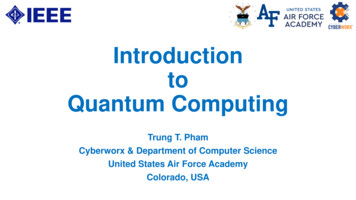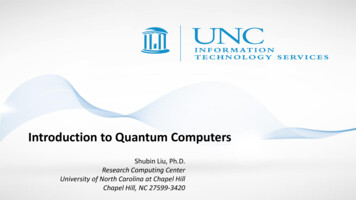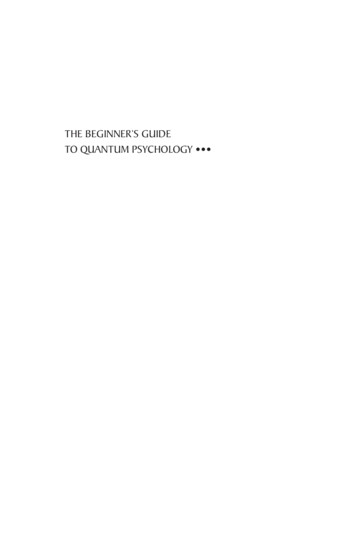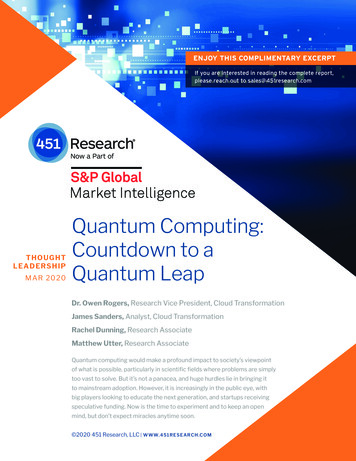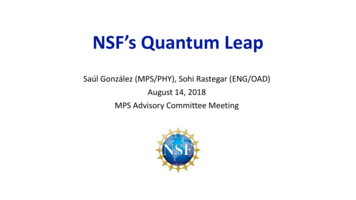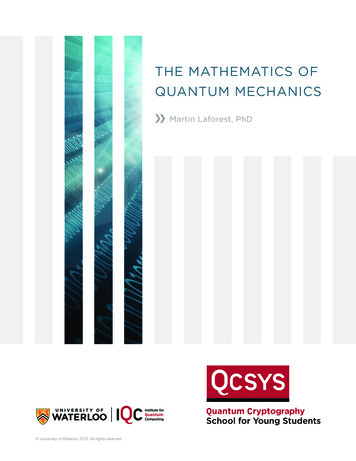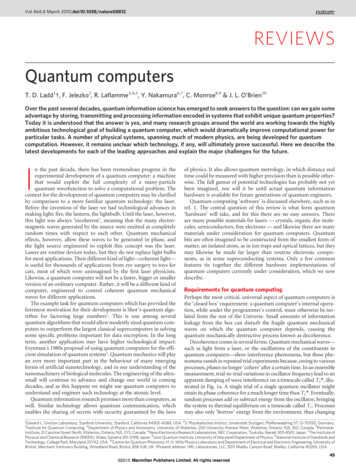
Transcription
Vol 464j4 March 2010jdoi:10.1038/nature08812REVIEWSQuantum computersT. D. Ladd1{, F. Jelezko2, R. Laflamme3,4,5, Y. Nakamura6,7, C. Monroe8,9 & J. L. O’Brien10Over the past several decades, quantum information science has emerged to seek answers to the question: can we gain someadvantage by storing, transmitting and processing information encoded in systems that exhibit unique quantum properties?Today it is understood that the answer is yes, and many research groups around the world are working towards the highlyambitious technological goal of building a quantum computer, which would dramatically improve computational power forparticular tasks. A number of physical systems, spanning much of modern physics, are being developed for quantumcomputation. However, it remains unclear which technology, if any, will ultimately prove successful. Here we describe thelatest developments for each of the leading approaches and explain the major challenges for the future.n the past decade, there has been tremendous progress in theexperimental development of a quantum computer: a machinethat would exploit the full complexity of a many-particlequantum wavefunction to solve a computational problem. Thecontext for the development of quantum computers may be clarifiedby comparison to a more familiar quantum technology: the laser.Before the invention of the laser we had technological advances inmaking light: fire, the lantern, the lightbulb. Until the laser, however,this light was always ‘incoherent’, meaning that the many electromagnetic waves generated by the source were emitted at completelyrandom times with respect to each other. Quantum mechanicaleffects, however, allow these waves to be generated in phase, andthe light source engineered to exploit this concept was the laser.Lasers are routine devices today, but they do not replace light bulbsfor most applications. Their different kind of light—coherent light—is useful for thousands of applications from eye surgery to toys forcats, most of which were unimagined by the first laser physicists.Likewise, a quantum computer will not be a faster, bigger or smallerversion of an ordinary computer. Rather, it will be a different kind ofcomputer, engineered to control coherent quantum mechanicalwaves for different applications.The example task for quantum computers which has provided theforemost motivation for their development is Shor’s quantum algorithm for factoring large numbers1. This is one among severalquantum algorithms that would allow modestly sized quantum computers to outperform the largest classical supercomputers in solvingsome specific problems important for data encryption. In the longterm, another application may have higher technological impact:Feynman’s 1980s proposal of using quantum computers for the efficient simulation of quantum systems1. Quantum mechanics will playan ever more important part in the behaviour of many emergingforms of artificial nanotechnology, and in our understanding of thenanomachinery of biological molecules. The engineering of the ultrasmall will continue to advance and change our world in comingdecades, and as this happens we might use quantum computers tounderstand and engineer such technology at the atomic level.Quantum information research promises more than computers, aswell. Similar technology allows quantum communication, whichenables the sharing of secrets with security guaranteed by the lawsIof physics. It also allows quantum metrology, in which distance andtime could be measured with higher precision than is possible otherwise. The full gamut of potential technologies has probably not yetbeen imagined, nor will it be until actual quantum informationhardware is available for future generations of quantum engineers.Quantum computing ‘software’ is discussed elsewhere, such as inref. 1. The central question of this review is what form quantum‘hardware’ will take, and for this there are no easy answers. Thereare many possible materials for lasers — crystals, organic dye molecules, semiconductors, free electrons — and likewise there are manymaterials under consideration for quantum computers. Quantumbits are often imagined to be constructed from the smallest form ofmatter, an isolated atom, as in ion traps and optical lattices, but theymay likewise be made far larger than routine electronic components, as in some superconducting systems. Only a few commonfeatures tie together the different hardware implementations ofquantum computers currently under consideration, which we nowdescribe.Requirements for quantum computingPerhaps the most critical, universal aspect of quantum computers isthe ‘closed box’ requirement: a quantum computer’s internal operation, while under the programmer’s control, must otherwise be isolated from the rest of the Universe. Small amounts of informationleakage from the box can disturb the fragile quantum mechanicalwaves on which the quantum computer depends, causing thequantum mechanically destructive process known as decoherence.Decoherence comes in several forms. Quantum mechanical waves—such as light from a laser, or the oscillations of the constituents inquantum computers—show interference phenomena, but these phenomena vanish in repeated trial experiments because, owing to variousprocesses, phases no longer ‘cohere’ after a certain time. In an ensemblemeasurement, trial-to-trial variations in oscillator frequency lead to anapparent damping of wave interference on a timescale called T2*, illustrated in Fig. 1a. A single trial of a single quantum oscillator mightretain its phase coherence for a much longer time than T2*. Eventually,random processes add or subtract energy from the oscillator, bringingthe system to thermal equilibrium on a timescale called T1. Processesmay also only ‘borrow’ energy from the environment, thus changing1Edward L. Ginzton Laboratory, Stanford University, Stanford, California 94305-4088, USA. 23. Physikalisches Institut, Universität Stuttgart, Pfaffenwaldring 57, D-70550, Germany.Institute for Quantum Computing, 4Department of Physics and Astronomy, University of Waterloo, 200 University Avenue West, Waterloo, Ontario, N2L 3G1, Canada. 5PerimeterInstitute, 31 Caroline Street North, Waterloo, Ontario, N2L 2Y5, Canada. 6Nano Electronics Research Laboratories, NEC Corporation, Tsukuba, Ibaraki 305-8501, Japan. 7The Institute ofPhysical and Chemical Research (RIKEN), Wako, Saitama 351-0198, Japan. 8Joint Quantum Institute, University of Maryland Department of Physics, 9National Institute of Standards andTechnology, College Park, Maryland 20742, USA. 10Centre for Quantum Photonics, H. H. Wills Physics Laboratory and Department of Electrical and Electronic Engineering, University ofBristol, Merchant Venturers Building, Woodland Road, Bristol, BS8 1UB, UK. {Present address: HRL Laboratories, LLC, 3011 Malibu Canyon Road, Malibu, California 90265, USA.345 2010 Macmillan Publishers Limited. All rights reserved
REVIEWSNATUREjVol 464j4 March 2010Environmentb T2 and T1a T2*Trial 1Trial 2Trial 3exp(–t/T2*)exp(–t/T2)AverageTimeTimeFigure 1 Dephasing and decoherence. a, An oscillator with frequencyvarying by trial, as indicated by the differently coloured waves, averages to anoscillation decaying with apparent dephasing timescale T2*. b, A quantumoscillator interacting with the environment may have phase-kicks in a singletrial; these are the processes that harm coherence in quantum computation,and lead to an average decay process of timescale T2. Equilibration processesare similar, and cause decay on the timescale T1 T2/2.the oscillator’s phase, causing oscillations to damp on a timescale calledT2, as illustrated in Fig. 1b. Fundamentally T2 # 2T1, and for mostsystems T1 ? T2, which means that T2 is more important for quantumcomputation.No system is fully free of decoherence, but small amounts of decoherence may be removed through various techniques gathered underthe name of ‘quantum error correction’ (QEC). Moreover, errors inquantum computers can be corrected using error-prone resources;that is, they may be made fault-tolerant1 for error probabilitiesbeneath a critical threshold that depends on the computer hardware,the sources of error, and the protocols used for QEC. Realistically,most of the resources used in a fault-tolerant quantum computer willbe in place to correct its own errors. If computational resources areunconstrained, the fault-tolerant threshold might be as high as 3%(ref. 2); values estimated under typical constraints are much smaller,on the order of 1025. The value of T2 is used as an initial characterization of many quantum systems, since, at a bare minimum, elementsof a quantum computer need to be operated much faster than T2 toallow fault-tolerance. However, other types of errors are just asimportant, and a large system often exhibits correlated noise processes distinct from T2 decoherence.An early characterization of the physical requirements for animplementation of a fault-tolerant quantum computer was carriedout by DiVincenzo3. A long T2 is the third of these criteria, but thisraises the question: what criteria must T2 be long enough to satisfy?Since DiVincenzo’s seminal work, the ideas for implementingquantum computing have diversified, and the DiVincenzo criteriaas originally stated are difficult to apply to many emerging concepts.Here, we rephrase DiVincenzo’s original considerations into threemore general criteria; these are stated with the assumption that theyare achievable while keeping decoherence ‘small enough’.Scalability. The computer must operate in a Hilbert space whosedimensions can grow exponentially without an exponential cost inresources (such as time, space or energy).The standard way to achieve this follows the first DiVincenzocriterion: one may simply add well-characterized qubits to a system.A quantum system with two states, such as a quantum spin withS 5 1/2, is a qubit. A qubit in a superposition of its two states is aquantum oscillator, and it inevitably experiences some amount of T1and T2 relaxation. A single qubit could be emulated by a classicaloscillator with a randomly timed, single-bit read-out, but quantummechanics also allows entanglement. As a result, the logic spacepotentially available on a quantum system of N qubits is describedby a very large group [known as SU(2N)], which is much larger thanthe comparable group [SU(2)flN] of N unentangled spins, andcannot be emulated by N classical oscillators or N classical bits.Ultimately, it is the large Hilbert space of a quantum computer thatallows it operations unavailable to classical computers. For qubits,the size and energy of a quantum computer generally grows linearlywith N. But qubits are not a prerequisite; quantum d-state systems(qudits) or quantum continuous variables may also enable quantumcomputation.Declaring a technology ‘scalable’ is a tricky business, because theresources used to define and control a qubit are diverse. They mayinclude space on a microchip, classical microwave electronics, dedicated lasers, cryogenic refrigerators, and so on. For a system to bescalable, these ‘classical’ resources must be made scalable as well,which invokes complex engineering issues and the infrastructureavailable for large-scale technologies.Universal logic. The large Hilbert space must be accessible using afinite set of control operations; the resources for this set must also notgrow exponentially.In the standard picture of quantum computing, this criterion(DiVincenzo’s fourth) requires a system to have available a universalset of quantum logic gates. In the case of qubits, it is sufficient to haveavailable nearly ‘analogue’ single-qubit gates (for example, arbitraryrotations of a spin-qubit), and almost any one ‘digital’ two-qubitentangling logic operation, such as the controlled-NOT gate.But quantum computers need not be made with gates. In adiabaticquantum computation4, one defines the answer to a computationalproblem as the ground state of a complex network of interactionsbetween qubits, and then one adiabatically evolves those qubits intothat ground state by slowly turning on the interactions. In this case,evaluation of this second criterion requires that one must askwhether the available set of interactions is complex enough, how longit takes to turn on those interactions, and how cold the system mustbe kept. As another example, in cluster-state quantum computation5,one particular quantum state (the cluster state) is generated in thecomputer through a very small set of non-universal quantum gates,and then computation is performed by changing the way in which theresulting wavefunction is measured. The qubits can be measured inarbitrary bases to provide the ‘analogue’ component that completesthe universal logic. Adiabatic and cluster-state quantum computersare equivalent in power to gate-based quantum computers4, but theirimplementation may be simpler for some technologies.Correctability. It must be possible to extract the entropy of the computer to maintain the computer’s quantum state.Any QEC protocol will require some combination of efficientinitialization (DiVincenzo’s second criterion) and measurement(DiVincenzo’s fifth criterion) to flush unwanted entropy introducedfrom the outside world out of the computer. Initialization refers tothe ability to cool a quantum system quickly into a low-entropy state;for example, the polarization of a spin into its ground state.Measurement refers to the ability to determine the state of a quantumsystem quickly with the accuracy allowed by quantum mechanics. Insome situations, these two abilities are the same. For example, aquantum non-demolition (QND) measurement alters the quantumstate by projecting to the measured state, which remains the sameeven after repeated measurements. Performing a QND measurementalso initializes the quantum system into the measured state. Therelationship between the need for initialization and measurementin QEC is complex; one may generally be replaced by the other. Ofcourse, some form of measurement is always needed to read out thestate of the computer at the end of a computation, and some amountof physical initialization is needed at the beginning, but how much isneeded is unclear; schemes have been developed to allow some formsof quantum computation with states of high entropy6–9.Quantum computation is difficult because the three basic criteria wehave discussed appear to be in conflict. For example, those parts of thesystem in place to achieve rapid measurement must be turned strongly‘on’ for error correction and read-out, but must be turned strongly ‘off’46 2010 Macmillan Publishers Limited. All rights reserved
REVIEWSNATUREjVol 464j4 March 2010to preserve the coherences in the large Hilbert space. Generally, neitherthe ‘on’ state nor the ‘off’ state is as difficult to implement as the abilityto switch between the two! In engineering a scalable quantum computer architecture, these conflicts are often aided by techniquesfor quantum communication; for this DiVincenzo introduced extracriteria related to the ability to convert stationary qubits to ‘flyingqubits’ such as photons. Quantum communication allows smallquantum computers to be ‘wired together’ to make larger ones, itallows specialized measurement hardware to be located distantly fromsensitive quantum memories, and it makes it easier to achieve thestrong qubit connectivity required by most schemes for fault-tolerance.The central challenge in actually building quantum computers ismaintaining the simultaneous abilities to control quantum systems,to measure them, and to preserve their strong isolation from uncontrolled parts of their environment. In the ensuing sections, weintroduce the various technologies researchers are currently employing to meet this challenge.PhotonsRealizing a qubit as the polarization state of a photon is appealingbecause photons are relatively free of the decoherence that plaguesother quantum systems. Polarization rotations (one-qubit gates) caneasily be done using ‘waveplates’ made of birefringent material.(Photons also allow the encoding of a qubit on the basis of locationand timing; quantum information may also be encoded in the continuous phase and amplitude variables of many-photon laserbeams10.) However, achieving the needed interactions betweenphotons for universal multi-qubit control presents a major hurdle.The necessary interactions appear to require optical nonlinearitiesstronger than those available in conventional nonlinear media, andinitially it was believed that electromagnetically induced transparency11 or atom–photon interactions enhanced by an optical cavity(cavity quantum electrodynamics)12 would be required.In 2001, a breakthrough known as the KLM (Knill–Laflamme–Milburn13) scheme showed that scalable quantum computing ispossible using only single-photon sources and detectors, and linearoptical circuits. This scheme relies on quantum interference withauxiliary photons at a beamsplitter and single-photon detection toinduce interactions nondeterministically. In the past five years, theKLM scheme has moved from a mathematical proof-of-possibilitytowards practical realization, with demonstrations of simplequantum algorithms14 and theoretical developments that dramatically reduce the resource overhead15. These developments employthe ideas of cluster-state quantum computing5, and have beendemonstrated experimentally15. Today, efforts are focused on highefficiency single-photon detectors16,17 and sources18,19, devices thatwould enable a deterministic interaction between photons11,12, andchip-scale waveguide quantum circuits14,20.Silicon single-photon detectors operate at room temperature at10 MHz with 70% efficiency; work is in progress to increase efficiencyand to resolve the photon number16,17. Superconducting detectorsoperating as sensitive thermometers can resolve the photon number,have 95% efficiency and low noise, but operate at ,100 mK and arerelatively slow. Faster (hundreds of MHz) nanostructured NbNsuperconducting nanowire detectors have achieved high efficiencyand photon number resolution16,17.One approach to a high-efficiency single-photon source is to multiplex the nonlinear optical sources currently used to emit pairs ofphotons spontaneously18. An alternative is a single quantum systemin an optical cavity that emits a single photon on transition from anexcited to a ground state. Robust alignment of the cavity can be achievedwith solid-state ‘artificial atoms’, such as quantum dots18,19,21,22 andpotentially with impurities in diamond23, which we discuss below. Asthese cavity quantum electrodynamics systems improve, they couldprovide deterministic photon–photon nonlinearities24.Regardless of the approach used for photon sources, detectors andnonlinearities, photon loss remains a significant challenge, andTable 1 Current performance of various qubitsType of qubitT2Benchmarking (%)ReferencesOne qubit Two qubitsInfrared photon0.1 ms0.016{Trapped ionTrapped neutral atom15 s3s0.485Liquid molecule nuclear spins2s0.01{3 ms0.6 s25 s2 ms4 ms55520.7{2e spin in GaAs quantum dote2 spins bound to 31P:28Si29Si nuclear spins in 28SiNV centre in diamondSuperconducting circuit1200.7*104–1061070.47{108510*43, 57495060, 61, 6573, 79, 81, 109Measured T2 times are shown, except for photons where T2 is replaced by twice the hold-time(comparable to T1) of a telecommunication-wavelength photon in fibre. Benchmarking valuesshow approximate error rates for single or multi-qubit gates. Values marked with asterisks arefound by quantum process or state tomography, and give the departure of the fidelity from100%. Values marked with daggers are found with randomized benchmarking110. Other valuesare rough experimental gate error estimates. In the case of photons, two-qubit gates failfrequently but success is heralded; error rates shown are conditional on a heralded success.NV, nitrogen vacancy.provides the closest comparison to T2 decoherence in matter-basedqubits (see Table 1). Like decoherence, loss can be handled by QECtechniques with high thresholds15. Typical values for loss in integrated waveguide devices are ,0.1 dB cm21. Current silica waveguide circuits14,20 use about one centimetre per logic gate (seeFig. 2), a length which may be reduced by using circuits with higherrefractive-index contrast. The advances in photonic quantum computing not only support photonic qubits, but are likely to benefitother types of quantum computer hardware using photons forquantum communication between matter qubits, including trappedatoms, quantum dots and solid-state dopants, as discussed below.Trapped atomsThe best time and frequency standards are based on isolated atomicsystems, owing to the excellent coherence properties of certain energylevels within atoms. Likewise, these energy levels in trapped atomsform very reliable qubits, with T1 and T2 times typically in the rangeof seconds and longer. Entangling quantum gates can be realizedthrough appropriate interactions between atoms, and atomic qubitscan be initialized by optical pumping and measured with nearly100% efficiency through the use of state-dependent optical fluorescence detection.Individual atomic ions can be confined in free space with nanometre precision using appropriate electric fields from nearby electrodes25,26, as shown in Fig. 3a and b. Multiple trapped ion qubits canbe entangled through a laser-induced coupling of the spins mediatedby a collective mode of harmonic motion in the trap. The simplestrealization of this interaction to form entangling quantum gates wasfirst proposed by Cirac and Zoller in 1995 and demonstrated in thelaboratory later that year25. Extensions to this approach rely onoptical spin-dependent forces that do not require individual opticaladdressing of the ions, nor the preparation of the ionic motion into aϕFigure 2 Photonic quantum computer. A microchip containing severalsilica-based waveguide interferometers with thermo-optic controlled phaseshifts for photonic quantum gates20. Green lines show optical waveguides;yellow components are metallic contacts. Pencil tip shown for scale.47 2010 Macmillan Publishers Limited. All rights reserved
REVIEWSNATUREjVol 464j4 March 2010acbdFigure 3 Trapped atom qubits. a, Multi-level linear ion trap chip; the insetdisplays a linear crystal of several 171Yb1 ions fluorescing when resonantlaser light is applied (the ion–ion spacing is 4 mm in the figure). Other laserscan provide qubit-state-dependent forces that can entangle the ions throughtheir Coulomb interaction. b, Surface ion trap chip with 200 zonesdistributed above the central hexagonal racetrack of width 2.5 mm(photograph courtesy of J. Amini and D. J. Wineland). c, Schematic ofoptical lattice of cold atoms formed by multi-dimensional optical standingwave potentials (graphic courtesy of J. V. Porto). d, Image of individual Rbatoms from a Bose condensate confined in a two-dimensional optical lattice,with atom–atom spacing of 0.64 mm (photograph courtesy of M. Greiner).pure quantum state, and are thus favoured in current experiments.Recently, up to eight trapped ion qubits have been entangled in thisway26. There are also proposals to use radio-frequency magnetic fieldgradients27 or ultrafast spin-dependent optical forces28 that do notrequire the ions to be localized to within an optical wavelength (theLamb–Dicke limit).The scaling of trapped-ion Coulomb gates becomes difficult whenlarge numbers of ions participate in the collective motion for severalreasons: laser-cooling becomes inefficient, the ions become moresusceptible to noisy electric fields and decoherence of the motionalmodes29, and the densely packed motional spectrum can potentiallydegrade quantum gates through mode crosstalk and nonlinearities25.In one promising approach to circumvent these difficulties, individual ions are shuttled between various zones of a complex trapstructure through the application of controlled electrical forces fromthe trap electrodes. In this way, entangling gates need only operatewith a small number of ions30.Another method for scaling ion trap qubits is to couple smallcollections of Coulomb-coupled ions through photonic interactions,offering the advantage of having a communication channel that caneasily traverse large distances. Recently, atomic ions have beenentangled over macroscopic distances in this way31. This type ofprotocol is similar to probabilistic linear optics quantum computingschemes discussed above13, but the addition of stable qubit memoriesin the network allows the system to be efficiently scaled to longdistance communication through quantum repeater circuits32.Moreover, such a system can be scaled to large numbers of qubitsfor distributed probabilistic quantum computing33.Neutral atoms provide qubits similar to trapped ions. An array ofcold neutral atoms may be confined in free space by a pattern of crossedlaser beams, forming an optical lattice34. The lasers are typically appliedfar from atomic resonance, and the resulting Stark shifts in the atomsprovide an effective external trapping potential for the atoms.Appropriate geometries of standing-wave laser beams can result in aregular pattern of potential wells in one, two or three dimensions, withthe lattice-site spacing scaled by the optical wavelength (Fig. 3c, d).Perhaps the most intriguing aspect of optical lattices is that the dimensionality, form, depth and position of optical lattices can be preciselycontrolled through the geometry, polarization and intensity of theexternal laser beams defining the lattice. The central challenges in usingoptical lattices for quantum computing are the controlled initialization, interaction and measurement of the atomic qubits. However,there has been much progress on all of these fronts in recent years.Optical lattices are typically loaded with 103–106 identical atoms,usually with non-uniform packing of lattice sites for thermal atoms.However, when a Bose condensate is loaded in an optical lattice, thecompetition between intrasite tunnelling and the on-site interactionbetween multiple atoms can result in a Mott-insulator transitionwhere approximately the same number of atoms (for example,one) reside in every lattice site34. The interaction between atomicqubits in optical lattices can be realized in several ways. Adjacentatoms can be brought together depending on their internal qubitlevels with appropriate laser forces, and through contact interactions,entanglement can be formed between the atoms. This approach hasbeen exploited for the realization of entangling quantum gate operations between atoms and their neighbours35. Another approachexploits the observation that when atoms are promoted to Rydbergstates, they possess very large electric dipole moments. The Rydberg‘dipole blockade’ mechanism prevents more than one atom frombeing promoted to a Rydberg state, owing to the induced level shiftof the Rydberg state in nearby atoms. Recently, the Rydberg blockadewas used to entangle two atoms confined in two separate opticaldipole traps36,37, and it should be possible to observe this betweenmany more atoms in an optical lattice.For trapped atoms and ions, coherence times are many orders ofmagnitude longer than initialization, multi-qubit control, and measurement times. The critical challenge for the future of trapped atomquantum computers will be to preserve the high-fidelity controlalready demonstrated in small systems while scaling to larger, morecomplex architectures.Nuclear magnetic resonanceNuclear spins in molecules in liquid solutions make excellent gyroscopes; rapid molecular motion actually helps nuclei maintain theirspin orientation for T2 times of many seconds, comparable to coherencetimes for trapped atoms. In 1996, methods were proposed6,7 for building small quantum computers using these nuclear spins in conjunctionwith 50 years’ worth of existing magnetic resonance technology.Immersed in a strong magnetic field, nuclear spins can be identified through their Larmor frequency. In a molecule, nuclear Larmorfrequencies vary from atom to atom owing to shielding effects fromelectrons in molecular bonds. Irradiating the nuclei with resonantradio-frequency pulses allows manipulation of nuclei of a distinctfrequency, giving generic one-qubit gates. Two-qubit interactionsarise from the indirect coupling mediated through molecular electrons. Measurement is achieved by observing the induced current in acoil surrounding the sample of an ensemble of such qubits.Liquid-state nuclear magnetic resonance has allowed the manipulation of quantum processors with up to a dozen qubits38, and theimplementation of algorithms39 and QEC protocols. This work wasenabled in large part by the development of quantum-informationinspired advances in radio-frequency pulse techniques building onthe many years of engineering in magnetic resonance imaging andrelated technologies; these techniques continue to improve40.Initialization is an important challenge for nuclear magnetic resonance quantum computers. The first proposals employed pseudopure-state techniques, which isolate the signal of an initialized purestate against a high-entropy background. However, the techniquesfirst suggested were not scalable. Algorithmic cooling techniques8may help this problem in conjunction with additional nuclear polarization. It was also noticed that for small numbers of qubits, pseudopure-state-based computation may be shown to lack entanglement41.Investigations of the consequences of this issue spurred insight intothe origin of the power of quantum computers and led to new modelsof quantum computation and algorithms9.One way to address the scalability limitation of pseudo-pure statesis to move to solid-state nuclear magnetic resonance, for which a48 2010 Macmillan Publishers Limited. All rights reserved
REVIEWSNATUREjVol 464j4 March 2010variety of dynamic nuclear polarization techniques exist. The lack ofmolecu
quantum computers currently under consideration, which we now describe. Requirements for quantum computing Perhaps the most critical, universal aspect of quantum computers is the 'closedbox'requirement: aquantumcomputer's internal opera-tion, while under the programmer's control, must otherwise be iso-lated from the rest of the Universe.
